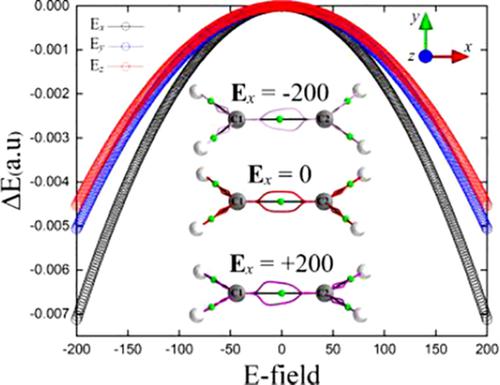当前位置:
X-MOL 学术
›
J. Comput. Chem.
›
论文详情
Our official English website, www.x-mol.net, welcomes your feedback! (Note: you will need to create a separate account there.)
Next‐generation QTAIM for scoring molecular wires in E‐fields for molecular electronic devices
Journal of Computational Chemistry ( IF 3 ) Pub Date : 2019-12-27 , DOI: 10.1002/jcc.26137 Alireza Azizi 1 , Roya Momen 1 , Herbert Früchtl 2 , Tanja van Mourik 2 , Steven R Kirk 1 , Samantha Jenkins 1
Journal of Computational Chemistry ( IF 3 ) Pub Date : 2019-12-27 , DOI: 10.1002/jcc.26137 Alireza Azizi 1 , Roya Momen 1 , Herbert Früchtl 2 , Tanja van Mourik 2 , Steven R Kirk 1 , Samantha Jenkins 1
Affiliation

|
The effect of a varying, directional E x, E y, and E z electric field on the ethene molecule was investigated using next‐generation quantum theory of atoms in molecules (QTAIM). Despite using low E‐field strengths that are within the realm of experiment and do not measurably alter the molecular geometry, significant changes to the QTAIM properties were observed. Using conventional QTAIM, the shifting of the C─C and C─H bond critical points (BCPs) demonstrates polarization through an interchange in the size of the atoms involved in a bond, since a BCP is located on the boundary between a pair of bonded atoms. Next‐generation QTAIM, however, demonstrates the polarization effect more directly with a change in morphology of the 3‐D envelope around the BCP. Modest increases of ≈ 2% in the ellipticity ε of the BCP were uncovered when the C─C bond was aligned parallel or anti‐parallel to the applied E x‐field. Significant asymmetries were found in the response of the next‐generation QTAIM 3‐D paths of the C─H bonds to the applied E‐field. When the E‐field coincided with the C─C bond, the BCP moved in response and was accompanied by the envelope constructed from 3‐D next‐generation paths. The response displayed a polarization effect that increased with increasing magnitude of the E x‐field parallel and anti‐parallel to the C─C bond. Our analysis demonstrates that next‐generation QTAIM is a useful tool for understanding the response of molecules to E‐fields, for example, for the screening of molecular wires for the design of molecular electronic devices. © 2019 Wiley Periodicals, Inc.
中文翻译:

用于在分子电子器件的电场中对分子线进行评分的下一代 QTAIM
使用分子中原子的下一代量子理论 (QTAIM) 研究了变化的、定向的 Ex、E y 和 E z 电场对乙烯分子的影响。尽管使用了实验范围内的低电场强度并且不会显着改变分子几何形状,但观察到 QTAIM 特性的显着变化。使用传统的 QTAIM,C─C 和 C─H 键临界点 (BCP) 的移动通过键中所涉及的原子大小的互换证明了极化,因为 BCP 位于一对键之间的边界上原子。然而,随着 BCP 周围 3-D 包络形态的变化,下一代 QTAIM 更直接地证明了极化效应。当 C─C 键与施加的 E x 场平行或反平行排列时,BCP 的椭圆率 ε 适度增加约 2%。在 C─H 键的下一代 QTAIM 3-D 路径对施加的电场的响应中发现了显着的不对称性。当电场与 C─C 键重合时,BCP 响应移动,并伴随着由 3-D 下一代路径构建的包络。响应显示出极化效应,随着与 C─C 键平行和反平行的 E x 场幅度的增加而增加。我们的分析表明,下一代 QTAIM 是了解分子对电场响应的有用工具,例如,用于分子电子器件设计的分子线筛选。© 2019 威利期刊公司。
更新日期:2019-12-27
中文翻译:

用于在分子电子器件的电场中对分子线进行评分的下一代 QTAIM
使用分子中原子的下一代量子理论 (QTAIM) 研究了变化的、定向的 Ex、E y 和 E z 电场对乙烯分子的影响。尽管使用了实验范围内的低电场强度并且不会显着改变分子几何形状,但观察到 QTAIM 特性的显着变化。使用传统的 QTAIM,C─C 和 C─H 键临界点 (BCP) 的移动通过键中所涉及的原子大小的互换证明了极化,因为 BCP 位于一对键之间的边界上原子。然而,随着 BCP 周围 3-D 包络形态的变化,下一代 QTAIM 更直接地证明了极化效应。当 C─C 键与施加的 E x 场平行或反平行排列时,BCP 的椭圆率 ε 适度增加约 2%。在 C─H 键的下一代 QTAIM 3-D 路径对施加的电场的响应中发现了显着的不对称性。当电场与 C─C 键重合时,BCP 响应移动,并伴随着由 3-D 下一代路径构建的包络。响应显示出极化效应,随着与 C─C 键平行和反平行的 E x 场幅度的增加而增加。我们的分析表明,下一代 QTAIM 是了解分子对电场响应的有用工具,例如,用于分子电子器件设计的分子线筛选。© 2019 威利期刊公司。


























 京公网安备 11010802027423号
京公网安备 11010802027423号